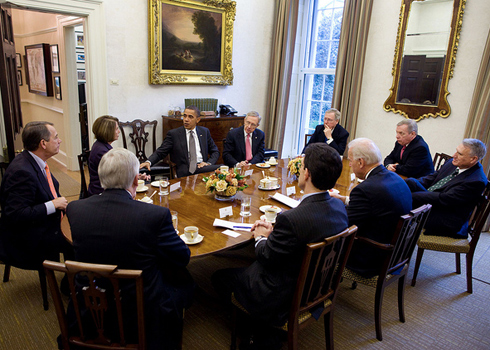If Republicans had their way, the Treasury Department wouldn’t be granted the authority to issue new debt unless and until Congress — two-thirds of both chambers — sent a radically conservative Constitutional amendment off to the states for ratification.
That’s what they’ll spend Tuesday proving to voters — particularly influential conservative leaders, who will be watching closely. In the House they’ll pass legislation called the Cut, Cap, and Balance Act which imposes swift, deep spending cuts, and promises to raises the debt limit into 2013 if and only if scores of Democrats agree to a version of the Balanced Budget Amendment that basically forbids tax increases, and holds spending below historic lows.
That means the functional end of popular entitlement programs — and that ain’t gonna happen. So then it’s on to another plan.
Taken in isolation this is pure political posturing — a waste of valuable time with the country less than two weeks away from defaulting on its payment obligations. But viewed within the full constellation of political pressures, it may be the only way to squeeze a bill to raise the debt limit through both the House and Senate on a bipartisan basis.
President Obama met with House GOP leaders over the weekend and on Monday, still in pursuit of an elusive “grand bargain” that would reduce deficits by $4 trillion over 10 years, largely through cuts to domestic and defense spending.
But the likeliest path to avoiding default remains this one — the escape hatch first proposed by Senate Minority Leader Mitch McConnell (R-KY) — the precise details of which are still evolving.
As currently conceived the plan would cut $1.5 trillion from discretionary spending — both defense and non-defense — and from mandatory spending, outside of the big three entitlement programs, Social Security, Medicare, and Medicaid. These were cuts identified by negotiators working with Vice President Joe Biden several weeks ago, and remain largely undisclosed. It would create a 12-member committee — House and Senate, six Democrats, six Republicans — to craft a much larger deficit reduction package that, if agreed to by the panel, would get streamlined votes in both chambers. And it would allow Republicans to register protest votes against raising the debt limit — the authority over which would be transfered to the White House through the end of 2012.
Under ordinary circumstances, a deal of this type — aimed people who rely most heavily on government services — would never happen. With health care largely firewalled it will have only a modest impact on the long-term deficit trajectory, so no great shakes if you’re a “true” fiscal hawk. It includes no new tax revenue, only spending cuts, so no great shakes if you’re a progressive, even if some of those cuts make sense. And it won’t fundamentally revisit the role the federal government plays in providing services to the old and needy, so it won’t appeal to conservatives or Republicans.
But at this point logic and sanity are becoming the enemies of the one true imperative — avoiding a catastrophic default — and everybody’s looking for a way to raise the debt limit without appearing to erase the numerous bright lines they’ve drawn in this negotiation.
That’s why we’re here.






